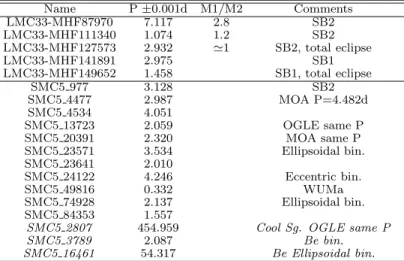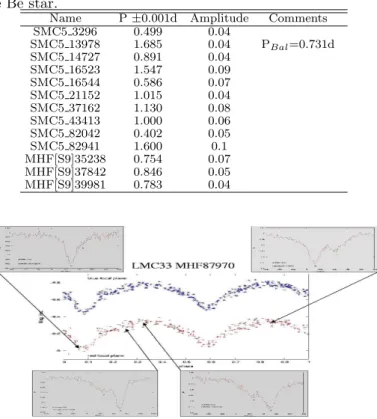HAL Id: hal-00018651
https://hal.archives-ouvertes.fr/hal-00018651
Preprint submitted on 6 Feb 2006HAL is a multi-disciplinary open access
archive for the deposit and dissemination of sci-entific research documents, whether they are pub-lished or not. The documents may come from teaching and research institutions in France or abroad, or from public or private research centers.
L’archive ouverte pluridisciplinaire HAL, est destinée au dépôt et à la diffusion de documents scientifiques de niveau recherche, publiés ou non, émanant des établissements d’enseignement et de recherche français ou étrangers, des laboratoires publics ou privés.
Short term variability in Be stars and binaries in the
Magellanic Clouds.
Christophe Martayan, Michele Floquet, Anne-Marie Hubert, Malek Mekkas
To cite this version:
Christophe Martayan, Michele Floquet, Anne-Marie Hubert, Malek Mekkas. Short term variability in Be stars and binaries in the Magellanic Clouds.. 2006. �hal-00018651�
ccsd-00018651, version 1 - 6 Feb 2006
**FULL TITLE**
ASP Conference Series, Vol. **VOLUME**, **YEAR OF PUBLICATION** **NAMES OF EDITORS**
Short term variability in Be stars and binaries in the Magellanic Clouds.
C. Martayan, M. Floquet, A.-M. Hubert, M. Mekkas
GEPI/UMR8111-Observatoire de Meudon, 5 place Jules Janssen 92195 Meudon cedex FRANCE
Abstract. We observed a large sample of B & Be stars in the Magel-lanic Clouds, respectively 176 and 344 stars, with the multi-object spectrograph GIRAFFE at ESO/VLT. We obtained spectra at different settings at various epochs. It allowed us to discover several spectroscopic binaries with short and intermediate periods. By cross-correlation in coordinates with the MACHO database, we found the light-curves for 350 stars in our samples. Among them, 19 (14 new) are photometric binaries (5 in the LMC, 14 in the SMC). Among these 19 photometric binaries 6 are also spectroscopic binaries (5 in the LMC, 1 in the SMC) and 2 others are Be stars (2 in the SMC). For all these bina-ries the orbital period was determined. Among our sample, 134 Be stars were observed by MACHO and, for these stars, we searched for short-term photo-metric variability. We have found 13 objects among Be stars in the SMC which present short-term photometric variability (P<2.5d) with amplitude lower than 0.1 magnitude. This short-term variability is often superimposed to a long-term variation.
1. Observations
Thanks to the VLT-FLAMES/GIRAFFE facilities in MEDUSA mode, a large sample of B and Be stars have been observed in the LMC-NGC2004 and SMC-NGC330 regions and their surroundings, 176 and 346 hot stars respectively. We used a medium resolution R=6400 in the blue wavelength range around Hγ (LR02) and R=8600 in the red one around Hα (LR06). Among this sample 178 Be stars were observed. We have cross-correlated the coordinates of observed stars with the MACHO and OGLE databases and we found light curves for 350 stars. Among them 134 are Be stars.
Blue spectra of B and Be stars in the LMC were obtained 4 days before red ones and it was therefore possible to study the variation of the stellar radial velocities and to detect spectroscopic binaries. Despite the small number of spectra for each object it was possible to estimate the mass ratio and the systemic velocity for some binaries (see Martayan et al. 2005a). By cross-correlation with the MACHO and OGLE databases we detected 19 photometric binaries. Among them 14 are new photometric binaries (5 in the LMC, 9 in the SMC). Among these 19 photometric binaries 6 are also spectroscopic binaries (5 in the LMC, 1 in the SMC) and 2 others are Be stars (2 in the SMC). For eclipsing binaries, the orbital period was determined with an accuracy of 0.001d.
2 C. Martayan, M. Floquet, A.-M. Hubert, M. Mekkas
2. Binaries
2.1. Binaries in the LMC
Thanks to observations with VLT-GIRAFFE spectrograph, we find 23 new bi-nary systems among the B stars of our sample (see Martayan et al. 2005a). The orbital periods were found thanks to the MACHO data. Results concerning eclipsing binaries are given in Table 1. As an example, the case of the LMC spectroscopic binary (SB2) MHF87970 (Porb=7.117d) is illustrated in Figure 1. Spectra obtained with the VLT-GIRAFFE are located at their orbital phases. The other eclipsing binaries are shown in Martayan et al. (2005a)
2.2. Binaries in the SMC
Contrary to the LMC, the observations in the blue and red wavelength have been done the same night and we cannot detect the variation of radial velocity. We find 14 eclipsing binaries. Periods were determined and compared to previous studies. Results are given in Table 1. The nature of SMC5 49816 is reconsidered and we propose SMC5 49816 like a WUMa binary because of its very short orbital period.
Table 1. Characteristics of eclipsing binaries in the Magellanic Clouds. The first column gives the name of the star, the second column gives the period of eclipses with an accuracy of±0.001d . The third column gives the ratio of masses and the last column gives different comments about the binary.
Name P ±0.001d M1/M2 Comments LMC33-MHF87970 7.117 2.8 SB2 LMC33-MHF111340 1.074 1.2 SB2 LMC33-MHF127573 2.932 ≃1 SB2, total eclipse LMC33-MHF141891 2.975 SB1 LMC33-MHF149652 1.458 SB1, total eclipse SMC5 977 3.128 SB2 SMC5 4477 2.987 MOA P=4.482d SMC5 4534 4.051 SMC5 13723 2.059 OGLE same P SMC5 20391 2.320 MOA same P SMC5 23571 3.534 Ellipsoidal bin. SMC5 23641 2.010 SMC5 24122 4.246 Eccentric bin. SMC5 49816 0.332 WUMa SMC5 74928 2.137 Ellipsoidal bin. SMC5 84353 1.557
SMC5 2807 454.959 Cool Sg. OGLE same P
SMC5 3789 2.087 Be bin.
SMC5 16461 54.317 Be Ellipsoidal bin.
3. Photometric variability in Be stars
As for galactic Be stars observed with Hipparcos (Hubert & Floquet 1998) and for Be stars candidates in the SMC (Mennickent et al. 2002), the short-term variability is often superimposed to a longer one which can be complex: short-, long-lived outbursts or fadings, periodic or pseudo-periodic variations. There-fore, when the Be stars lightcurves are not too complicated, we searched for
Short term variability in Be stars and binaries. 3
short-term variability by using PDM and FT+CLEAN algorithm methods. Un-der these conditions we find that 13 Be stars present short-term photometric variability (P<2.5d) with amplitude lower than 0.1 magnitude. Results are given in Table 2. The value of periods of short-term variations seem to be of the same order in the MC and in our Galaxy (see Hubert & Floquet 1998). We observed 6 stars proposed by Mennickent et al. (2002) as Be stars candidates and we confirm their Be nature. Due to their complex light curves it was not possible to investigate the short-term variability of Be stars in the sample in the LMC.
Table 2. Characteristics of short-term photometric variability in Be stars in the Magellanic Clouds. The first column gives the name of the star, the second column gives the period with an accuracy of ±0.001d . The third column gives the amplitude and the last column gives different comments about the Be star.
Name P ±0.001d Amplitude Comments
SMC5 3296 0.499 0.04 SMC5 13978 1.685 0.04 PBal=0.731d SMC5 14727 0.891 0.04 SMC5 16523 1.547 0.09 SMC5 16544 0.586 0.07 SMC5 21152 1.015 0.04 SMC5 37162 1.130 0.08 SMC5 43413 1.000 0.06 SMC5 82042 0.402 0.05 SMC5 82941 1.600 0.1 MHF[S9]35238 0.754 0.07 MHF[S9]37842 0.846 0.05 MHF[S9]39981 0.783 0.04
Figure 1. Binary LMC33-MHF87970, P=7.117d, MACHO60.7950.16. The central panel shows the MACHO lightcurves in phase. The four little panels show the GIRAFFE spectra and their correspondence with the phases.
References
Balona, L. A., 1992, MNRAS, 256, 425
Bayne, G., Tobin, W., Pritchard, J. D., et al., 2002, MNRAS, 331, 609B Hubert, A.-M., Floquet, M., 1998, A&A, 335, 565
Martayan, C., Hubert, A.-M., Floquet, M. et al., 2005a, A&A, in press, astroph0509339 Mennickent, R. E., Pietrzy´nski, G., Gieren, W., et al., 2002, A&A, 393, 887

